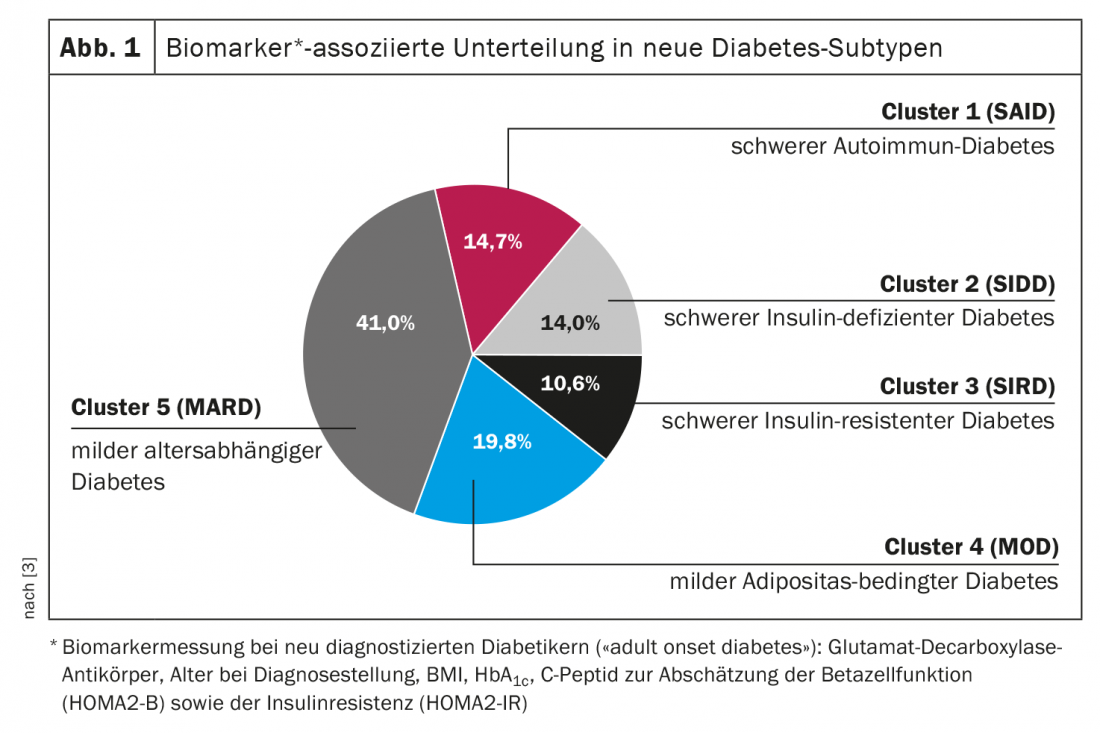Phenotyping and subclassification of diabetic patients is becoming increasingly important to provide patient-adapted treatment options. Meanwhile, there are several cluster analyses that could reveal certain specific patterns of patient characteristics. One conclusion is that stratification of type 2 diabetics may be useful to optimize disease management.
At the EASD Virtual Meeting, Miriam Udler, MD, Harvard Medical School Boston, reported on recent research findings in this area [1]. More than 90% of all diabetics are currently categorized as type 2 diabetics, with the remaining proportion divided between type 1 diabetics and a hodgepodge of other forms of diabetes (e.g., MODY) [2]. Empirical findings show, however, that type 2 diabetes in particular is a very heterogeneous clinical picture [3]. More sophisticated subtyping is important for several reasons, she said. First, therapy can be more specific to the individual problem. Secondly, a reliable prediction of the course of the disease as well as expected complications is more likely to be possible. Third, risks for associated adverse health effects can be estimated [1]. The subclassification of diabetes can be made on the basis of various criteria. On the one hand, a classification by type of data is possible (clinical phenotypes vs. genotype-phenotype correlations), and on the other hand, there are conceptual trade-offs that enter in. Here it must be clarified whether it is a static categorization or a subdivision with fluid boundaries and whether it is more like a class division or a continuum.
Phenotype clusters based on analyses of registry data.
An important publication in this context is a study by Ahlqvist et al. published in the Lancet, in which the authors performed a data-driven cluster analysis in patients with newly diagnosed diabetes (n=8980) [3]. The datasets were from the Swedish All New Diabetics in Scania cohort registry. The authors were able to identify five replicable patient clusters, which were characterized by significantly different patient characteristics and risk factors for subsequent disease. The five clusters (Overview 1) are based on the following variables measured at the time of diagnosis: Glutamic acid decarboxylase antibody, age at diagnosis, BMI, HbA1c, C-peptide to estimate beta cell function (HOMA2-B), and insulin resistance (HOMA2-IR). The cluster designations are as follows: SAID (severe autoimmune diabetes), SIDD (severe insulin-deficient diabetes), SIRT (severe insulin-resistant diabetes), MOD (mild obesity-related diabetes), MARD (mild age-related diabetes). The different clusters are characterized by different levels of insulin resistance as well as different risk for the occurrence of complications [4]. SAID is essentially the same as classic type 1 diabetes. The remaining four clusters can be assigned to type 2 diabetes. Among others, patients in cluster 3 (most severe insulin resistance) had a significantly higher risk of diabetic kidney disease than patients in clusters 4 and 5. However, patients in all three clusters received similar medication. Furthermore, the analyses revealed that cluster 2 (insulin-deficient) was characterized by the highest risk of retinopathy. Other important findings include cluster SIRD as a severe form of diabetes with marked insulin resistance and fatty liver progression and more rapid development of nephropathy.
In addition to the large Swedish registry data analysis by Ahlqvist et al. several other studies on diabetes subtyping have been published in the meantime, which came to similar conclusions, including data from Germany, China and the USA [5,6].

Shift to other clusters in disease progression.
As shown, among others, in the study by Zaharia et al. 2019 was shown, cluster assignment can change during disease progression [5]. Whether diabetes outcomes are better predicted by clustering or by individual characteristics was investigated by Dennis et al. 2019 studied on the basis of two RCTs. They, too, were able to use the cluster classification of Ahlqvist et al. verify [7]. Individual characteristics used were sex, age at diagnosis, baseline BMI, and HbA1c. Predictive power was found to be similar for clustering versus individual characteristics, with specificities regarding various outcome parameters. Regarding glycemic control, age at diagnosis proved to be an equivalent predictive parameter as cluster assignment. Baseline eGFR, on the other hand, proved to be a better predictive parameter than cluster subtyping with regard to development of chronic kidney disease. For treatment and HbA1c improvement, individual characteristics were better predictors than clustering [7]. It may be useful to use either specific decision-relevant criteria or these two approaches of individual characteristics and clustering in parallel, she said.
| Summary
Stratification into the SAID, SIDD, SIRT, MOD, and MARD clusters (Overview 1) may allow for more targeted and early treatment in the future so that patients receive the greatest benefit from therapy. In addition to the large Swedish registry data analysis by Ahlqvist et al. several other studies on diabetes subtyping have been published in the meantime, which came to similar conclusions, including data from Germany, China and the USA [5,6]. It has been shown that type 2 diabetes in particular is very heterogeneous with respect to genetic biomarkers. Thus, analyses resulted in hundreds of significant genetic risk loci that could be correlated with disease-relevant physiological characteristics [8]. |
Clinical or genetic biomarkers or both?
Within the RADIANT (Rare and Atypical Diabetes Network) initiative, there are several projects on genetic subtyping of diabetes. The example of a monogenically inherited form of diabetes shows that 1 genetic variant explains most of the disease risk. This subtype of diabetes is assigned to the residual category in the current classification system. Analyses show that type 2 diabetes is characterized by hundreds of significant genetic risk loci [8]. Subdividing the type 2 diabetes category based on polygenic scores is a meaningful approach, the speaker explained. Here, 47 diabetes-related traits and 94 genetic variants (representing loci) were correlated and divided into polygenic scores using cluster analysis, which in turn were correlated with diabetes-related physiological mechanisms (e.g., obesity, adipose tissue, islets of Langerhans, etc.) [9]. This resulted in 5 clusters, two of which (beta cells, proinsulin) could be assigned to the insulin deficiency criterion and three (obesity, lipodystrophy, liver/lipid) to the insulin resistance criterion. As part of the Roadmap epigenomics Project, it has been shown that the subdivision into gene loci can be mapped to tissue specificities and suspected disease mechanisms [9]. In a study by Mahajan et al. [10] the cluster assignment was verified using an approach in which distinct but overlapping gene loci were identified and correlated with disease-relevant mechanisms. In another empirical study, data from over 17,000 patients with type 2 diabetes from different cohort studies were analyzed by calculating an individual process-specific polygenic score for each cluster. Based on this, percentiles were identified which were found to be specific to each cluster [9]. “Polygenic risk scores for diabetes have been shown to stratify,” the speaker summarized. Approximately 30% of all type 2 diabetics could be classified into one of these clusters. The beta-cell cluster was associated with reduced C-peptide levels, the obesity cluster had the highest BMI levels, the lipodystrophy cluster had increased C-peptide levels (link to insulin resistance), and the liver/lipid cluster was characterized by reduced triglyceride levels [9].
Source: EASD 2020
Literature:
- Udler MS: Sub-classification of diabetes: possibilities and challenges, Miriam S. Udler, MD, PhD, EASD Virtual Meeting, 9/23/20.
- McKeever Bullard K, et al. : Prevalence of Diagnosed Diabetes in Adults by Diabetes Type – United States, 2016; MMWR Morb Mortal Wkly Rep 2018; 67(12): 359-361.
- Ahlqvist E, et al: Novel subgroups of adult-onset diabetes and their association with outcomes: a data-driven cluster analysis of six variables. The Lancet Diabetes and Endocrinology 2018; 6(5): 361-369.
- Vetter C: Type 1 and 2 diabetes: five clusters map diabetes severity and disease-associated risks. Dtsch Arztebl 2019; 116(47): A-2195/B-1795/C-1751
- Zaharia OP, et al: Risk of diabetes-associated diseases in subgroups of patients with recent-onset diabetes: a 5-year follow-up study. Lancet Diabetes Endocrinol 2019; 7(9): 68-694.
- Zou X, et al: Novel subgroups of patients with adult-onset diabetes in Chinese and US populations. Lancet Diabetes Endocrinol 2019; 7(1): 9-11.
- Dennis JM, et al. Disease progression and treatment response in data-driven subgroups of type 2 diabetes compared with models based on simple clinical features: an analysis using clinical trial data. Lancet Diabetes Endocrinol 2019 ; 7(6): 442-451.
- Udler MS, et al. : Genetic Risk Scores for Diabetes Diagnosis and Precision Medicine. Endocr Rev 2019 Dec; 40(6): 1500-1520.
- Udler MS, et al: Type 2 diabetes genetic loci informed by multi-trait associations point to disease mechanisms and subtypes: A soft clustering analysis. PLoS Med 2018; 15(9): e1002654.
- Mahajan A, et al: Refining the accuracy of validated target identification through coding variant fine-mapping in type 2 diabetes. Nature Genetics 2018; 50: 559-571.
CARDIOVASC 2021; 20(1): 32-33 (published 2/3/21, ahead of print).












